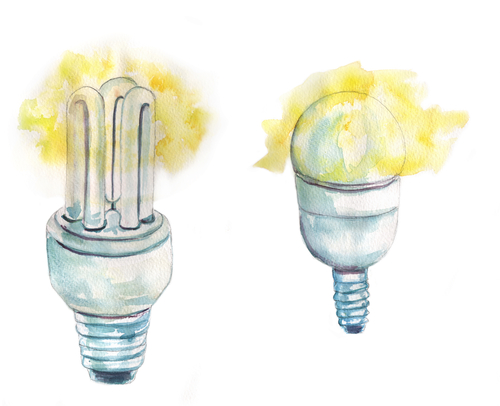Lightbulbs: Facts Versus Fiction
 |
The phase out of incandescent bulbs set in motion by the Energy Independence and Security Act (EISA) of 2007 was intended, in part, to eventually eliminate inefficient incandescent lightbulbs, known as “general service lamps,” and increase use of more efficient lighting technologies. Along the way, however, confusion has grown about new and different types of bulbs, which is best for the job at hand, as well as how to replace incandescent bulbs in appliances and equipment. Here are some facts to consider about lightbulbs that you may not know.
Not all incandescent bulbs are included in the EISA. There are actually 22 kinds of incandescent lightbulbs, or “lamps,” that are exempt as “specialty” bulbs. These are used in a range of products and applications, including appliance bulbs, colored lamps, marine lamps, shatter-resistant lamps, heavy-duty bulbs, traffic signals, and others. That said, the Department of Energy (DOE) is monitoring sales of these bulbs and if sales double on any type of bulb—indicating they are taking market share from bulbs covered under the EISA—the DOE is required to establish an energy conservation standard for that particular bulb type. A complete list of EISA-exempt bulbs is available at http://energy.gov/energysaver/articles/frequently-asked-questions-lighting-choices-save-you-money#all.
Forget expensive calls to lawyers and consultants. With Enviro.BLR.com, you get instant access, 24/7. Try it out today and get the 2015 EHS Salary Guide, absolutely free. Download Now.
The cost of the energy saved really does far exceed the higher cost of energy efficient bulbs. According to the DOE, replacing the five most-often-used lightbulbs in a building with Energy Star-rated bulbs can save $75 per year. On a per-bulb basis*, the DOE says, “Average consumers will spend about $4.80 to operate a traditional incandescent bulb for a year (electricity cost). By comparison, average consumers will spend about $1.00 to operate an ENERGY STAR LED [light emitting diode] bulb, about $3.50 on a halogen incandescent bulb, and about $1.20 on an ENERGY STAR CFL [compact fluorescent lamp] bulb—each that produces about the same amount of light.”
Energy-efficient bulbs really do last longer than incandescent bulbs… a lot longer. The DOE says, given the same amount of light emitted, an Energy Star-qualified CFL lasts 10 times longer than an incandescent bulb and an Energy Star-qualified LED lamp lasts 25 times longer.
Everything You Need for Environmental Compliance
Enviro.BLR.com puts everything you need at your fingertips, including practical RCRA, CAA, CWA, hazardous waste regulatory analysis and activity, news, and compliance tools. Try it at no cost or risk and get a FREE report.
There are no energy-efficient bulbs that work with dimmer switches. According to the Environmental Protection Agency (EPA), there are Energy Star-qualified CFL bulbs available that are designed to work with dimmer switches. However, always check the bulb’s package to be sure that a dimmer switch is among the proper applications and that there are no related restrictions. Use of a CFL that is not meant for a dimmer switch “can shorten its life significantly.” In addition, the same is true for CFLs used in a three-way socket, and EPA says, “Manufacturers are trying to make it easier for consumers by labeling their products with special features, or lack thereof, on the front of the packaging as well as in the fine print.”
The process of manufacturing energy-efficient CFL bulbs actually uses more energy than that of incandescent bulbs so the gains in efficiency are skewed. Not true, says the EPA, which claims there are three reasons CFLs use “substantially less energy (and cause fewer emissions of greenhouse gases)” than equivalent incandescent bulbs, factoring in energy used in manufacture:
“(1) a CFL uses substantially less energy when it is on than an incandescent bulb does, 75% less,
(2) one CFL will last up to ten times longer than an incandescent, so an appropriate comparison includes 8 or more incandescent for every CFL, and
(3) manufacturers tell us it takes much less energy to manufacture a CFL than the energy it will use over its lifetime. ENERGY STAR recognizes CFLs based on the energy used while the bulb is on, helping consumers choose the bulb with lowest overall energy use and green house gas emissions.”
* For 60 W replacement bulbs, based on 2 hrs/day of usage, shown in U.S. dollars.
